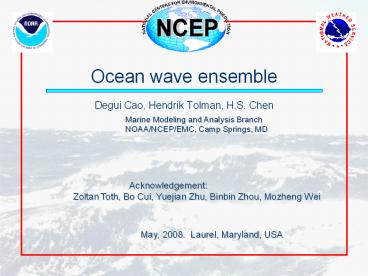Ocean wave ensemble - PowerPoint PPT Presentation
Title:
Ocean wave ensemble
Description:
Swell is sensitive to its initial conditions, and should include perturbation ... Tentatively realistic swell perturbation ... the role of swell played in the ... – PowerPoint PPT presentation
Number of Views:138
Avg rating:3.0/5.0
Title: Ocean wave ensemble
1
Ocean wave ensemble
- Degui Cao, Hendrik Tolman, H.S. Chen
Marine Modeling and Analysis Branch
NOAA/NCEP/EMC, Camp
Springs, MD
Acknowledgement Zoltan Toth, Bo
Cui, Yuejian Zhu, Binbin Zhou, Mozheng Wei
May, 2008.
Laurel, Maryland, USA
2
Generation and evolution of ocean wave
- The generation and evolution of the wind
waves are strongly dependent on external wind
forcing. The wave nonlinear term plays the
stabilization role on the wave perturbation in
the wind-wave evolution. Wind sea is not
sensitive to its initial conditions (spectrum,
frequency ) unlike the chaotic systems. This
makes the wave (wind sea) weak nonlinearity.
Swell is sensitive to its initial conditions, and
should include perturbation consistent with its
generation. - Wind sea actively generated waves
- Swell freely propagating waves with no
local forcing
3
Status of ensemble systems
- Current operation system (old system)
- Wave ensemble has been operational since
2005 - Running on old deterministic global model grid
(1.251) as the control - 10 wave members generated through GEFS using the
breeding method. - Same initial conditions for all members.
- 5 day (126 h) forecast.
- Wind data raw wind data
- Validation
- Nearly 50 buoys in the northern hemisphere.
4
Status of ensemble systems
- New ensemble system
- Wave ensemble has been parallel running
since April 2008 - Running on 11 wave model grid as the control.
- 20 wave members generated through GEFS using ETR
method - Cycling initial conditions for individual members
to introduce uncertainty in swell results. - 10 day forecast using the GEFS bias corrected 10m
wind (future operation) - 5 day (126 hour) forecast using the raw wind data
( testing only)
5
Status of ensemble systems
- New ensemble system
- Validation
- 145 buoys in the northern hemisphere
- altimeter wave data (ENVISAT, GFO, Jason-1)
6
Validation of the old ensemble system
- Data
- Ensemble forecast data
- From Jun. 5, 2006 to Mar. 31, 2007
- Observation data
- NDBC hourly buoy data
- Climate data
- Hourly wave height and wind climate data
generated using 10 years NDBC buoy datasets from
Jan. 1997 to Dec. 2006.
7
Validation of the old ensemble system
Global buoy distribution used in the old ensemble
system verification
8
Validation of the old ensemble system
Skill scores against climatology slowly decrease
with forecast lead time. Better skill for waves
then for winds. Lack of data for higher parameter
values.
9
Validation of the old ensemble system
Skill scores against control run slowly increase
with forecast lead time. Better skill for waves
then for winds. Lack of data for higher parameter
values.
10
Validation of the old ensemble system
Hs gt 2m day 5
Hs gt 4m day 5
There is a clear lack of spread in the wave
heights, and a positive bias in particular for
higher wave heights.
11
Validation of the old ensemble system
U10 gt 10m/s day 5
U10 gt 14m/s day 5
There is a clear lack of spread in the wave
heights, and a positive bias in particular for
higher wave heights.
12
Validation of the old ensemble system
13
Comparison of the ensemble systems
old
cycle
Old ensemble setup, ensemble with cycling of
initial conditions and wind bias correction
(BC). Mean wave height (contours) and spread
(shading) 2008/03/28 t06z nowcast
cycle, BC
14
Comparison of the ensemble systems
old
cycle
Old ensemble setup, ensemble with cycling of
initial conditions and wind bias correction
(BC). Mean wave height (contours) and spread
(shading) 2008/03/28 t06z 48h forecast
cycle, BC
15
Comparison of the ensemble systems
old
cycle
Old ensemble setup, ensemble with cycling of
initial conditions and wind bias correction
(BC). Mean wave height (contours) and spread
(shading) 2008/03/28 t06z 120h forecast
cycle, BC
16
Contribution to the ensemble theory
- Perturbation of the wave initial
conditions to generate the wave ensemble member
has limited liability in the wave ensemble
forecast. Its ensemble member is generated
through - the GEFS (forcing) ensemble system.
- The uncertainties come from
- 1). Observation analysis
- 2). Model physics and
parameterization - 3). External forcing, system
interaction
17
Conclusions
- New wave ensemble shows 2-5 day memory
of wind perturbations in wave system. - Tentatively realistic swell perturbation
- Continuity in perturbations in GEFS between model
cycles is critical.
18
Future plan
- Validate the new ensemble system with buoys and
altimeter data - Compare of the new and old ensemble systems
- Bias corrected wind from GEFS is expected to
reduce (remove) wave bias in ensemble. - Cycling of initial conditions will increase
variability of wave heights (partial solution ?) - Work towards a combined NCEP-FNMOC ensemble
- Analyze the role of swell played in the wave
ensemble































